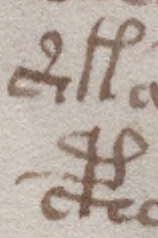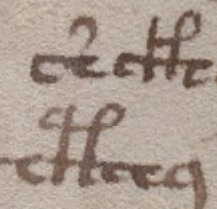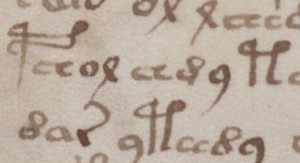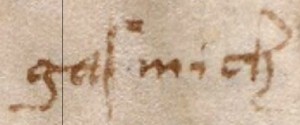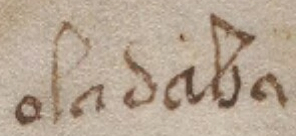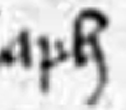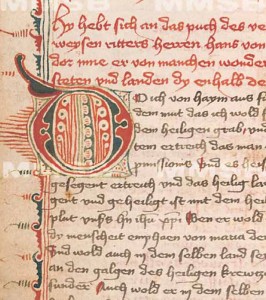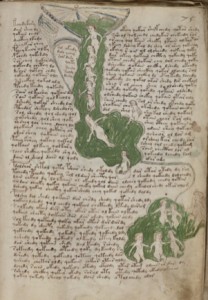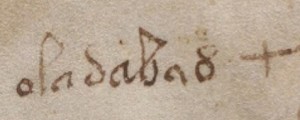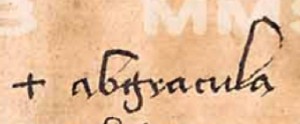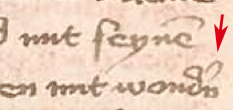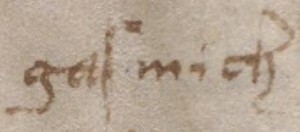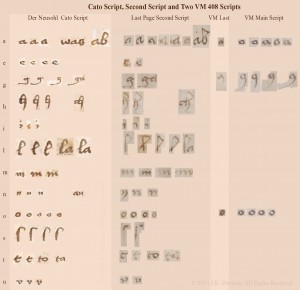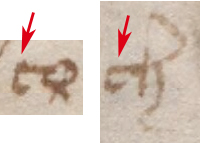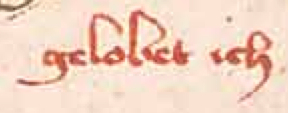Introduction
In a previous post, I compared the writing style on the final page of the Voynich Manuscript to other writers living in the early 15th century, but what about the “words” themselves. The letter groups that look almost, but not quite German?
Is it possible to examine them both individually and together and make any sense of them?
There has been quite a bit of discussion, for example, that the first “word” after the plus sign is michiton or mchiton or anchiton. Before discussing this word, I’d like to back up a little, since the text at the very top is often overlooked.
The Word Groups in Detail
If you assume the last page text of the Voynich Manuscript was written left to right and top to bottom, then the first “word” on the page is something like “poxleben”. The third character looks like a closed-loop “x” where ink filled in the loop. The letter “x” was sometimes written this way in 14th century French documents and there are similar “x” shapes lower down in the VM.
The “e” shapes are written in fairly common Gothic script for the time, with a tiny nick on the top-right curve rather than a distinct crossbar. The “c” is slightly more curved. The difference is subtle, but if you look at many old manuscripts, you learn to distinguish them. In 15th century English documents with scripts similar to this, the crossbar on the “e” was usually written with more emphasis, so the style leans toward Bohemia which, at the time, included part of northern Italy (later, as the glass industry went into full swing, there was significant cross-pollination of skills between the Slavic/German/Czech and Italian glassblowers).
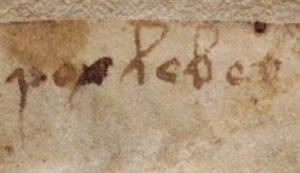
In German, “leben” is life—”to live” “to exist” and “leber” is liver. In Basque, “leben” means “idea”.
The “pox” is puzzling. In English, pox is a spot-creating disease or a curse, but it’s not a typical German word. Pox in German is pocken (as in a disease that creates spots that leave pock marks). In some regions, the word pox more specifically referred to syphilis. Together “poxleben” might mean something entirely different than the two separately “pox leben/leber”, or this page might be another example of cipher.
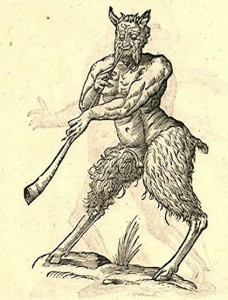 In a philosophy thesis submitted to the University of Wisconsin in 1902, Charles H. Handschin references the phrase from a poet, “Ey, schendt sie pox leber und lung” and equates “pox” to “bock(s)” (buck/male animal/Billygoat) which, in turn, he equates to “teufel” (devil). It brings to mind the image of a man-goat (satyr).
In a philosophy thesis submitted to the University of Wisconsin in 1902, Charles H. Handschin references the phrase from a poet, “Ey, schendt sie pox leber und lung” and equates “pox” to “bock(s)” (buck/male animal/Billygoat) which, in turn, he equates to “teufel” (devil). It brings to mind the image of a man-goat (satyr).
Handschin’s interpretation of a 16th century phrase might shed light on the meaning of pox leber, or it might be a stretch to assume similar meanings. Perhaps the VM is not “pox leber” at all, but “pox, leber, und lung” as in pox, liver, and lung but with minimal punctuation as is common to quickly written notes and many older manuscripts.
Perhaps the rest of the text will yield more clues.
After poxleben/pox leben/pox leber?, the next two letter groupings, which are near the darker top edge, are difficult to discern.

The first letter might be a “u”. The letter “u” was often written like a “v” and, in many manuscripts, could be difficult to distinguish without context. What follows resembles “men” or “mon” (blumen is “flowers” in German, could “umen” be trees?). Perhaps it’s “um an” (two words).
The next word might start with a “u”, “v”, or perhaps a “p”. You would need a microscope to see if the descender is a mark in the parchment or ink. The next letter resembles a vowel, but is hard to read. Then there is a reasonably distinct “t” followed by what looks like “i” and “r” (or a disconnected “p”) and then what appears to be an “f” (unlike “s”, it has a crossbar) and then “e” and something very difficult to discern but probably an “r”. It’s a difficult one that looks like putirfe? or putpfer. In German, p is sometimes followed by “f” (as in pferd, horse). If the last letter is a “v” shape with a disconnected continuation of the bottom, the “feu” (French for fire/flame) is also possible.
Perhaps the reason there has been so little discussion about this line of text is because it’s not clear enough to decipher, but it still offers clues in that the letter groupings resemble the way syllables are combined in European languages.
Then there is a gap and a grouping of three lines that appear to be associated with each other both by proximity and by the cross shapes that appear between word-shapes. This is where we have the famous “michiton” which I’m pretty sure is “anchiton” based on comparing the zodiac labels and Second Script text on the final page.
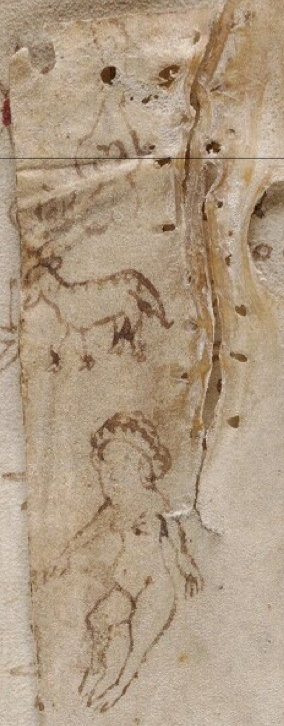
poxleben/pox leben/pox leber umen/um an u?tirfeu?/p?tpfeu/putifer/nuti?fer/putrifer
+ anchiton + oladabad/ola?abad/oladabas + miltod/miltos + re + toe? ceue/teue + portad/portas + n? +
six + marix/inarix + mocix/morix + vix + ahia/aka + ma + ma/uia/ria +
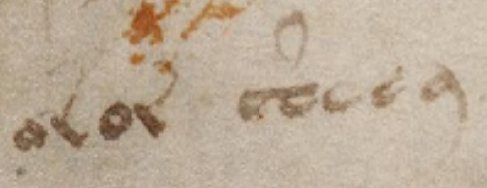 valden/ualden/valsen ubren so nim gasmich/gas mich
valden/ualden/valsen ubren so nim gasmich/gas mich 
The word-group after the first plus sign is unlikely to be michiton. If you use all the loops usually needed for an “m” then there’s no stroke for an “i” and there’s no dot over the last stroke. I think more likely it’s anchiton, with a slightly crooked “a”. It’s not likely to be nichiton either. See the chart of letter shapes below to understand my reasoning for leaning toward anchiton.
The “six” line is even more enigmatic than the previous. Lots of “-ix” and “-a” endings.
The word six means the same thing in French and English (the number 6). Note that four words in a row, at the start of the middle line, end in “x”. There are a number of Latin words that end this way, including vix, as does pyx in Czech. Note also that the next three words all end in “a”. It’s almost like an incantation, especially when preceded by something like anchiton oladabad/oladabas which has the same feel as abracadabra. Could these fragments be suffixes or prefixes, words that have been collapsed, or parts of a code with no direct relation to words in any language?
Note the “ix” ending on the first four groups and the “a” on the last three.
-ix + –ix + –ix + -ix + –a + -a + –a
Preceding “ix” it appears there are 1, 3, 3, 1 letters. Preceding “a” are 2, 1, 2 letters. It’s not enough context to discern a pattern, but it doesn’t appear to be natural language. It seems systematic, formulaic.
Normally I would consider the word group after vix to be ahia (especially since there is a mark that could be a tick over the “i”), but I’ve noticed the occasional manuscript in which a k is rendered like an h with no tail, with an extra “loop” added on the right, so there’s a small possibility this could be a “k”, especially since the tick is very faint and might coincidentally be a mark on the parchment. I’m leaning toward it being ahia, but it’s probably wise to consider both possibililties.
The third line begins with two VM text word-groups, followed by additional Second Script.
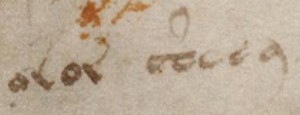 valsen/valden ubren so nim gas mich
valsen/valden ubren so nim gas mich
The word mich (or possibly mith) is followed by a characteristic VM drawing of something resembling a plummeting stone. Thus, we have VM drawings and text on the left, and a VM-style mini-drawing on the right, with Second Script worked in around and between the two VM word-groups as though they were written in the same ink at the same time. Note how the quill pen has been dipped just before aror and fades on the next word, then has been dipped again before valden and fades on the next word.
The “a” shape is quite different in the two scripts, but perhaps the VM “a” isn’t based on “a”. Perhaps it’s just a VM shape that looks to us like an a-shape, something like a small pot with a straight lid, tilted to one side, if you want to be imaginative. It’s already been mentioned in one of my previous posts that the Cato front-leaf writer compressed rather angular text to a smoothly curving symbol, so we can’t 100% assume a cipher text will contain the same pen characteristics as the coder’s regular handwriting. It’s possible the Second Script writer might have copied VM text, but the VM text is so dead-on similar to the rest of the manuscript, it’s hard to believe it was written by anyone but the VM author.

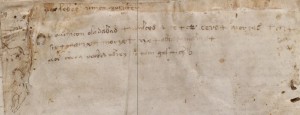
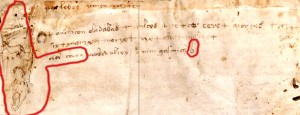
The enigmatic integration of the Vm text with the rest of the text suggests the possibility that the Second Script writer and the VM author are the same person despite the different styles of handwriting.
The ink on this page is quite consistent, in contrast to the Second Script labels on the zodiac wheels, which are typically darker than the surrounding text. Are there one, two or three writers? Or was this page written in a different point in time than the labels on the zodiac symbols?
When the ink from this page was tested, some ink from the VM words at the beginning of the line should have been sampled to see whether they differ from the Second Script text.
An analysis of the individual letter forms will help determine whether there are two or three writers notating the Voynich Manuscript. I’ve written about the zodiac labels in a previous post and created a chart of the months, most of which are written in French. This chart is based on previously deciphering those letters, but it’s harder to make out the letters on the final page because the words themselves are not in a recognizable language. The “d” shape in the chart below might not be a “d” at all (it could be “s” or something else), but it’s similar to how a “d” was written at the time, so I’ve listed it in the “d” row for convenience.
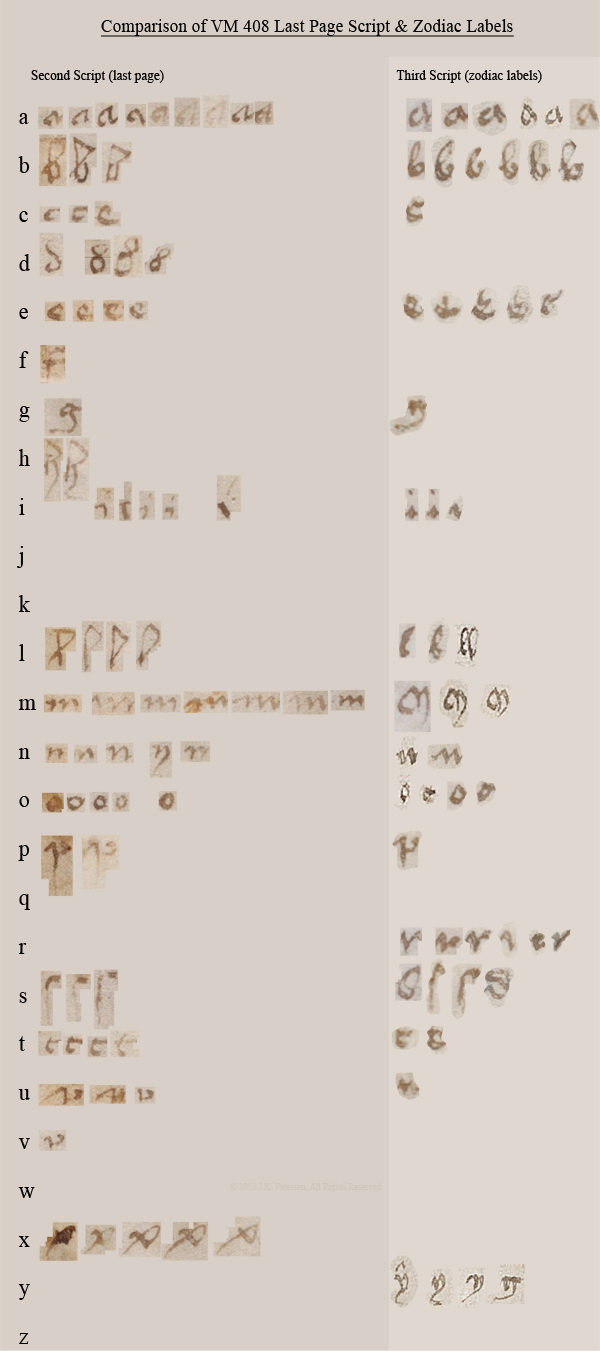
Some letters are very similar, like the “p” and the “t”, but it quickly becomes apparent that whoever labeled the zodiacs is probably not the same writer who penned the cryptic text on the last page. Not only are the letter shapes different (especially the b, e, i, and m), but the stroke order differs, as well. You can’t see this difference from looking at only one letter, but when you compare several, it becomes more apparent, as in the way the “a” is written.
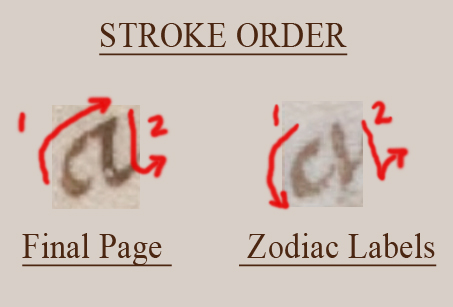
While there is still a possibility that the final page scribe and whoever labeled the zodiacs are the same person, the handwriting suggests they probably are different people living in somewhat the same time period. Since I’m reasonably sure they are not the same, I’ll be referring to the final page writing as Second Script, and the zodiac labels as Third Script, to distinguish them from the main VM text.
Note also the “i”-shape in vix. It looks like a more assertive, backward leaning character more similar to VM text than Second Script. Was this an unconscious slip or was it already on the page? The “o” in mocix also looks a little more VM than Second Script.
Final Page Voynich Drawings
There hasn’t been much discussion about the drawings on the last page. The focus has been on viewing the cryptic text as a possible decipherment key and the images have been largely overlooked.
In the top left corner is an erect phallic shape that extends almost off the top of the page. It might be symbolic, it might be a body organ, or something unclear. Upon first seeing it, I couldn’t help thinking of the Phallus Impudicus (Satyr’s mushroom) illustrated by Ulisse Aldrovandi (16th century). To the left of what resembles testicles is a short letter grouping that looks like las/fas or lad/fad. Unfortunately, it crosses a fold and is indistinct. Underneath it, a sheep or goat or some other fuzzy animal with cloven hooves, drawn in the same style as the zodiac animals, meanders to the left. Under it is a typical VM naked woman in a headdress who might be recently pregnant or post-partum. She appears to be sitting or sliding downward. To the right of the sheep are the two VM-style word groups and, at the end of the Second Script text, is the “plummeting rock”.
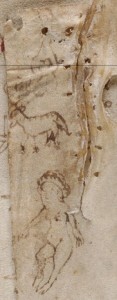


Was this page originally intended to be an additional page to the main text that was never completed or a rough draft for something that was later expressed in a different way? Why are the figures so close to the edge of the parchment? Do the drawings have anything to do with the two VM words?
And why is the page narrower than others? Was this piece of parchment cut along the left to remove something? Might there have been a column of letters as has been wiped out from the first page? Has it also been trimmed at the top, where the words are so close to the edge?
There are many possibilities. The same person may have penned both the Second Script and VM text. The Second Script, which resembles the ciphering example in Der Neusohler Cato, may have existed before the VM writer or illustrator added to this page, or the Second Script may have been added after the VM illustrator included the drawings.
J.K. Petersen
Addendum: I was planning to upload more of my notes about the actual content of the enigmatic script, but I simply don’t have time and it would have made this blog entry too long. Much has been written about the last page of the Voynich possibly being a decoding “key” but having looked at it for a while, I doubt this. It’s my belief that the coded word on the front fly of the Der Neusohler Cato and the last page of the Voynich are charms (in the case of the Voynich, possibly a healing charm). Look at the formulaic structure of the words (especially the ones in the middle) and the plus signs. This is typical of medieval charms in northern Europe. I have many details, examples of similar charms (e.g., the margin of a Sloane manuscript), and images, but I simply can’t spare time to locate the parts spread all over my hard drive and assemble it into a blog. As mentioned in other notes, I work ridiculously long hours, trying to cope in a new global economy, but I will do it as soon as I can find time.
© Copyright 2013 J.K. Petersen, All Rights Reserved
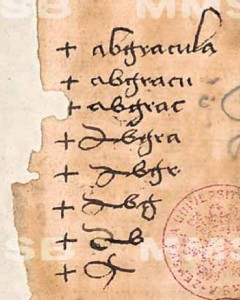 I guessed that the coded word at the beginning of Der Neusohler Cato might be a charm/symbol and that it might have a similar function to the text on the last page of the Voynich almost two years before I found time to read about medieval charms. My hunch was based on its sound and character.
I guessed that the coded word at the beginning of Der Neusohler Cato might be a charm/symbol and that it might have a similar function to the text on the last page of the Voynich almost two years before I found time to read about medieval charms. My hunch was based on its sound and character.















